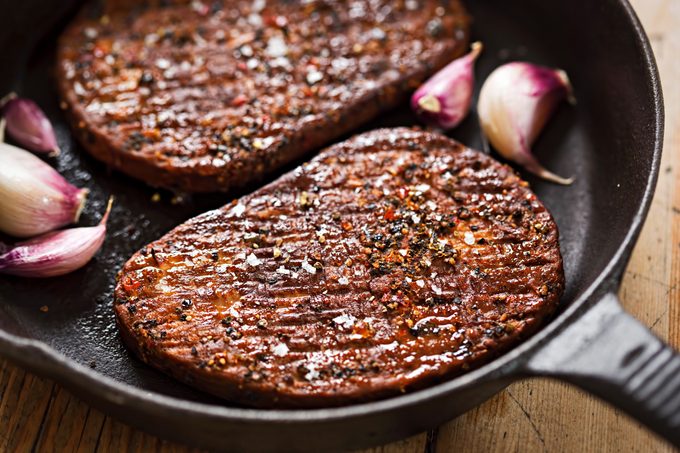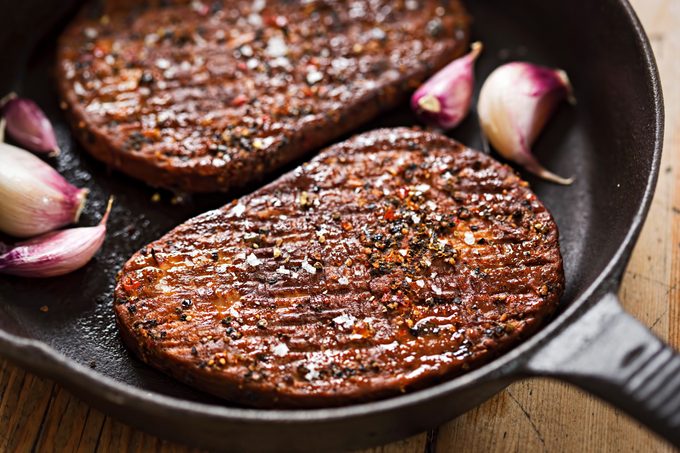More people are looking for meat substitutes
Plant-based eating is on the rise, and with it comes a growing market for meat substitutes.
In a 2020 report, market research company Statista revealed that the multi-billion dollar meat substitute market is primarily made up of soy products. However, the second-largest market share goes to mycoprotein, a vat-grown, fungus-based food predicted to rake in $504 million in 2022.
Like soy, mycoprotein comes in many forms: deli “meat” slices, burger-like patties, “chicken” nuggets, and more.
However, while you can find soy products from dozens of manufacturers, you’re only likely to find one mycoprotein brand. Mycoprotein is “used as an ingredient in products marketed under the Quorn trademark,” according to a 2019 report in Nutrition Today.
Curious about this meatless protein? Here’s what you need to know about mycoprotein, its nutrition content, benefits, side effects, and how to eat it.
What is mycoprotein, exactly?
Mycoprotein is a protein that comes from Fusarium venenatum, a naturally occurring fungus.
As a meat substitute product, mycoprotein is “made by fermenting fungus spores with glucose and other nutrients,” says Vicki Shanta Retelny, RDN and author of The Essential Guide to Healthy Healing Foods and host of the Nourishing Notes podcast.
According to Amy Gorin, RDN, a plant-based registered dietitian and owner of Plant-Based Eats in Stamford, Connecticut, mycoprotein-based products contain significant amounts of protein and other nutrients, such as fiber.
Mycoprotein nutrition
Mycoprotein is primarily made up of protein and fiber. Because mycoprotein products contain a blend of other ingredients, nutrition facts also vary.
According to a 2019 report in Current Developments in Nutrition, 100 grams (about 3.5 ounces) of pure, food-grade mycoprotein contains the following nutrients:
Calories: 85
Protein: 11 g (22 percent Daily Value or DV)
Fat: 2.9 g (4 percent DV)
Carbohydrates: 3 g (1 percent DV)
Fiber: 6 g (21 percent DV)
Sodium: 5 mg (0 percent DV)
Zinc: 9 mg (82 percent DV)
Iron: 0.5 mg (3 percent DV)
Mycoprotein vs. ground beef
Vegan and vegetarians often tout plant-based proteins as healthier than animal products. In a head-to-head comparison of mycoprotein and ground beef, the fungal protein is clearly leaner and less salty—but it also contains less iron, an essential mineral.
For comparison, 100 grams (3.5 ounces) of raw ground beef contains:
Calories: 198
Protein: 19.4 g (39 percent DV)
Fat: 12.7 g (16 percent DV)
Carbohydrates: 0 g (0 percent DV)
Fiber: 0 g (0 percent DV)
Sodium: 68 g (3 percent DV)
Zinc: 4.6 g (42 percent DV)
Iron: 2 mg (11 percent DV)
Types of mycoprotein
Quorn, a company that has trademarked mycoprotein in the United States and Great Britain, offers a variety of mycoprotein products. The fungus fermentation process gives each product a slightly spongy, meat-like texture. However, the final flavor and form of each product can differ dramatically.
“One thing to note is that many of the products are gluten-free, but some are not because they may contain barley-based ingredients,” notes Gorin. She adds that “many products made with mycoprotein are vegan, [but] others are vegetarian because they may contain egg.”
Health benefits of mycoprotein
Plant-based eating has been a growing wellness trend for the last several years. But the rise of vegetarian fast food reveals that meatless menus don’t always translate to healthier eating.
By swapping your burger for a mycoprotein patty, you can eat fewer calories, cut back on sodium, reduce fat intake, and replace an animal product with plant-based protein. “It may also help blood cholesterol levels, help control blood sugar levels, and help promote fullness,” Gorin says.
She also emphasizes an environmental perk: “The way [mycoprotein] is produced means there is less of a carbon and water footprint compared to the production of beef and chicken.”
Both nutrition experts recommend eating various plant-based proteins rather than relying on mycoprotein (or tofu or tempeh) alone. Shanta Retelny says that though mycoprotein is different from meat alternatives such as soy products, it’s important to remember that “it’s not necessarily better.”
Mycoprotein may promote weight loss
If you are already pursuing a vegan diet for weight loss, mycoprotein could be an excellent addition to your protein rotation.
“Mycoprotein is a protein-rich meat alternative that’s low in fat with no cholesterol,” says Shanta Retelny. She also adds that it is rich in fiber, which promotes weight loss, according to a 2019 study published by the science journal American Society for Nutrition.
However, it’s important to remember that no single food will help you magically lose weight. And processed meat alternatives such as mycoprotein are high in sodium, which is known to raise your risk of diabetes, kidney stones, and bloating.
Risks and side effects
“There have been some concerns about the safety of mycoprotein. The Center for Science in the Public Interest published a report noting concerns such as potential allergic reactions or reactions that occur after a sensitivity has been established,” says Gorin.
A 2018 article published in the science journal Annals of Allergy, Asthma, and Immunology analyzed 1,752 adverse reactions to mycoprotein. It concluded, “Mycoprotein may be causing numerous and sometimes life-threatening allergic and gastrointestinal reactions.”
However, the risk seems to be tiny, says Gorin. “A 2019 review study in Current Development in Nutrition found that allergic reactions to mycoprotein are ‘exceptionally low.’”
The bottom line? Read mycoprotein product labels for sensitive ingredients. Shanta Retelny cautions against eating mycoprotein if you have a known mold allergy.
How to know if mycoprotein is right for you
Both Gorin and Shanta Retelny say that mycoprotein can be a nutritious alternative to meat. They also emphasize reading product labels in search of allergens and information about animal products because some Quorn offerings are vegetarian but not vegan.
“As with any nutrient, I encourage variety when it comes to getting your daily protein intake. So mycoprotein is a good option to incorporate into your diet, but I would continue to look to other plant-based sources as well, including beans, legumes, tofu, and edamame,” Gorin says.
How to shop for mycoprotein
You can usually find a variety of mycoprotein products at your local supermarket. It’s also available online or at some health food stores. Most mycoprotein products are sold under the brand name Quorn.
Like many other meat substitutes, mycoprotein products are highly processed. Each product contains different ingredients, so pay careful attention to the label if you are vegan or have food allergies.
How to eat mycoprotein
“It’s not a bad idea to change up your protein sources—animal or plant-based meat alternatives—throughout the week,” says Shanta Retelny. She recommends focusing on balance and staying aware of product ingredients, potential allergens, or contaminants.
Adding mycoprotein to your protein rotation is easy because the products are sold ready-to-eat (such as Quorn’s Meatless Turkey-Style Deli Slices) or pre-seasoned for cooking (such as Quorn’s Meatless Gourmet Burgers).
“There are many mycoprotein convenience products,” says Gorin. “Think ground ‘meat,’ deli slices, burgers, and ‘chicken’ nuggets. These can be incorporated into meals just as you would use non-vegetarian versions!”
To keep your meals healthy, Gorin recommends serving mycoprotein with vegetables, avocado slices, and whole-grain buns.
The post 9 Things Nutritionists Want You to Know About Mycoprotein Meat Substitutes appeared first on The Healthy.








